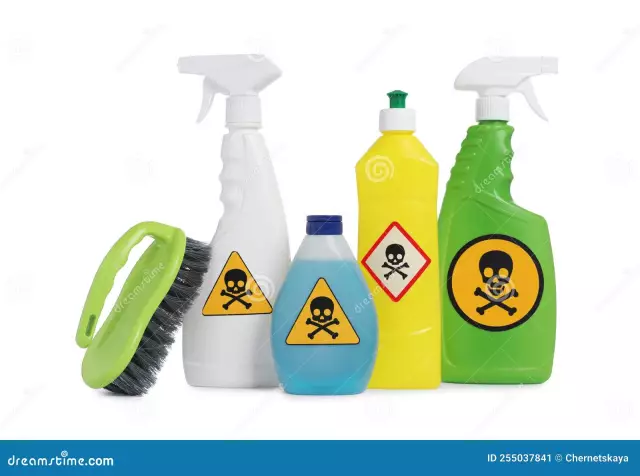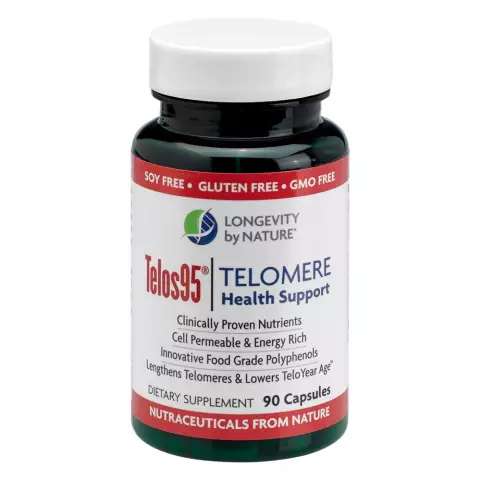- Author Rachel Wainwright [email protected].
- Public 2023-12-15 07:39.
- Last modified 2025-11-02 20:14.
Household chemicals: convenience to the detriment of health
The life of a modern woman is very difficult. There are many options for self-realization: this is not only education and career, but also a variety of hobbies, from sports to needlework. It is equally important to build a personal life, paying maximum attention to children, husband, parents, friends. There is a sorely lack of time for all matters, so every woman tries to do the necessary, but not the most exciting housework as quickly as possible - in which household chemicals (liquids, powders, pastes, gels, etc.), a wide range which sellers offer. Unfortunately, not all such products are safe for health.

Source: depositphotos.com
Hazardous components of household chemicals
Dishwashing liquids, gels, powders and sprays for cleaning enamel and faience surfaces, metal, tiles and glass, floor and carpet cleaning products, furniture polish, washing powders and fabric conditioners, air fresheners … Any apartment has at least at least two or three dozen packages with different household "helpers". And the more we use them, the more we risk the health of family members. The danger of these funds is a direct consequence of their main positive quality: chemical activity in relation to pollution. Household chemicals contain ingredients that are harmful to health:
- anionic surfactants (surfactants). They are found in most dishwashing detergents, kitchen countertops, stoves, sanitary ware and tiles, as well as detergents. These substances bind fat residues and other contaminants very well, but are dangerous because they themselves are poorly washed off from the surfaces to be cleaned. It is believed, for example, that it is possible to completely remove surfactants from washed dishes only if the object is under a stream of clean water for at least 20 seconds. Human skin, repeatedly exposed to surfactants, dehydrates and ages quickly. When ingested, substances of this type accumulate in the tissues of the brain, liver and other organs, which significantly increases the risk of developing heart attacks, strokes, severe damage to the nervous system and a decrease in immunity. Some products add cationic surfactants,safe for humans;
- chlorine compounds. They are found in large quantities in bleach and bathroom cleaners and disinfectants. Extremely toxic. They have a strong carcinogenic effect, disrupt the functioning of the cardiovascular system, irritate mucous membranes, worsen the condition of nails, hair and skin;
- phosphates. Very common components of laundry detergents that can effectively remove dirt from fabric fibers. With prolonged contact with the skin, they penetrate the pores into the body and can adversely affect the blood composition. Cause liver and kidney damage, severe dermatitis;
- nitrobenzene. A toxic volatile compound found in parquet and furniture care products. When applied to surfaces by spraying, it easily enters the respiratory system. May cause acute poisoning with vomiting, diarrhea, shortness of breath and seizures. Contact with nitrobenzene is especially dangerous for expectant mothers, since this substance freely penetrates the placental barrier and can cause severe fetal malformations;
- ammonia. Contained in glass and mirror cleaning liquids and sprays, sanitary ware cleaners. Irritating to the mucous membranes of the eyes and respiratory system. Prolonged contact is fraught with headache, imbalance and even loss of consciousness;
- phthalates (phthalic acid salts). Popular components of air fresheners. Negatively affect the work of the endocrine glands;
- formaldehyde. An ingredient in many household chemicals produced in the form of sprays. It is considered a dangerous carcinogen and mutagen. If a pregnant woman enters the body, it increases the risk of having a baby with asthma;
- phenolic and cresol compounds. Due to their high bactericidal activity, they are often included in toilet bowl cleaners. These are very corrosive substances that can cause poisoning and adversely affect vision;
- fragrances and flavors. They are indispensable components of products that require a pleasant smell (washing powders, dishwashing liquids, air fresheners, etc.). They are natural, synthetic and semi-synthetic. Can provoke an allergic reaction.

Source: depositphotos.com
How to clean your home without harming your health
As we can see, almost every product used to facilitate the work of the housewife contains components that are harmful to health. It is problematic to completely eliminate the use of such products in everyday life, but you can minimize their potential danger by following a number of simple rules:
- when purchasing dishwashing detergents and detergents, choose those that contain no more than 5% anionic surfactants. Rinse each washed item in running water for as long as possible;
- purchase detergents that do not contain phosphates;
- completely abandon household chemicals containing chlorine compounds;
- use a gauze respirator when working with powders and volatile liquids;
- try to limit the use of aerosols;
- do not contact with household chemicals without rubber gloves;
- minimize the number of varieties of chemical "helpers" around the house. For example, you can use the same product to clean the dishes, stove, sink, and kitchen countertops.
There is another way to minimize the harm that we do to our health in the process of putting things in order in the house: the use of long-known and well-proven folk remedies for cleaning and disinfection. Of course, you should not scrub the pots with sand, like our great-grandmothers, but washing the dishes with a mixture of mustard powder and baking soda is not difficult. Vinegar, citric acid (or lemon juice), baby or laundry soap, borax (sodium tetraborate) are great help in everyday life. An air freshener is easy to make on your own: just add a few drops of essential oil (for example, lemon, orange, mint, lavender) to the water poured into a container with a spray. The only drawback of such a tool is its unsuitability for long-term storage, but it is quite possible to do it a little and use it quickly.

Source: depositphotos.com
In general, when working with household chemicals, it is necessary to follow the principle "less is more." It is worth using a minimum amount of powders, liquids, pastes and gels, and carefully selected, with a predominantly natural composition that do not contain frankly dangerous components. This is expensive and may slightly reduce the quality of cleaning. It may take more time and effort to put things in order with this approach, but the health of your family members will undoubtedly pay off the cost.
YouTube video related to the article:

Maria Kulkes Medical journalist About the author
Education: First Moscow State Medical University named after I. M. Sechenov, specialty "General Medicine".
Found a mistake in the text? Select it and press Ctrl + Enter.






